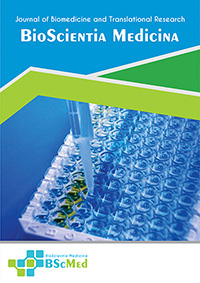Main Article Content
Abstract
Background: Catamenial pneumothorax, a rare manifestation of thoracic endometriosis syndrome (TES), presents a significant diagnostic and therapeutic challenge. It is characterized by recurrent spontaneous pneumothorax occurring in temporal relation to menstruation in women of reproductive age. The underlying pathophysiology is complex, often involving the ectopic presence of endometrial tissue within the thoracic cavity. Coexisting pelvic pathologies, such as adenomyosis, may be associated, further complicating the clinical picture.
Case presentation: We present the case of a 38-year-old woman with a four-month history of recurrent, right-sided pneumothorax, with symptoms consistently commencing 24 to 48 hours prior to the onset of her menstrual cycle. Initial investigations, including high-resolution computed tomography of the thorax performed between menstrual cycles and microbiological analysis for tuberculosis, were unremarkable. The diagnosis of catamenial pneumothorax was established based on the distinct cyclical pattern of her symptoms. A subsequent gynecological evaluation, prompted by a history of secondary dysmenorrhea and menorrhagia, revealed uterine adenomyosis via transvaginal ultrasonography. The patient was managed through a collaborative, multidisciplinary approach involving pulmonology, thoracic surgery, and gynecology. Treatment consisted of chemical pleurodesis with doxycycline, administered via a chest tube, followed by continuous hormonal suppression therapy with oral progestin (2 mg/day).
Conclusion: This case highlights the critical importance of maintaining a high index of suspicion for catamenial pneumothorax in women of reproductive age presenting with recurrent pneumothorax. A successful outcome was achieved through a coordinated, multidisciplinary strategy combining definitive pleural symphysis via pleurodesis with systemic hormonal therapy to suppress the underlying endometriotic process. This dual approach effectively prevented pneumothorax recurrence over a 12-month follow-up period, underscoring its efficacy in managing this complex condition.
Keywords
Article Details
As our aim is to disseminate original research article, hence the publishing right is a necessary one. The publishing right is needed in order to reach the agreement between the author and publisher. As the journal is fully open access, the authors will sign an exclusive license agreement.
The authors have the right to:
- Share their article in the same ways permitted to third parties under the relevant user license.
- Retain copyright, patent, trademark and other intellectual property rights including research data.
- Proper attribution and credit for the published work.
For the open access article, the publisher is granted to the following right.
- The non-exclusive right to publish the article and grant right to others.
- For the published article, the publisher applied for the Creative Commons Attribution-NonCommercial-ShareAlike 4.0 International License.





